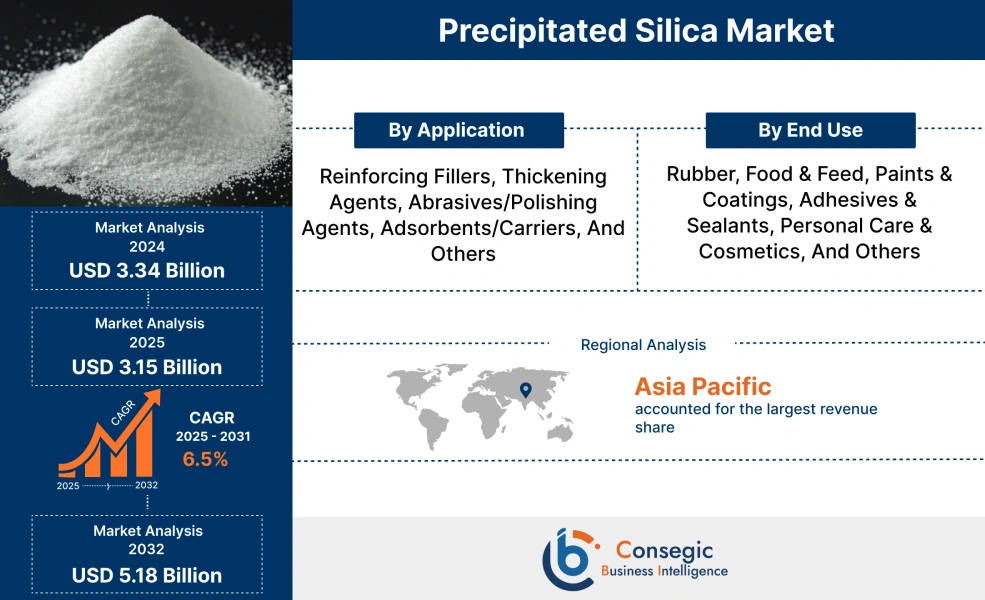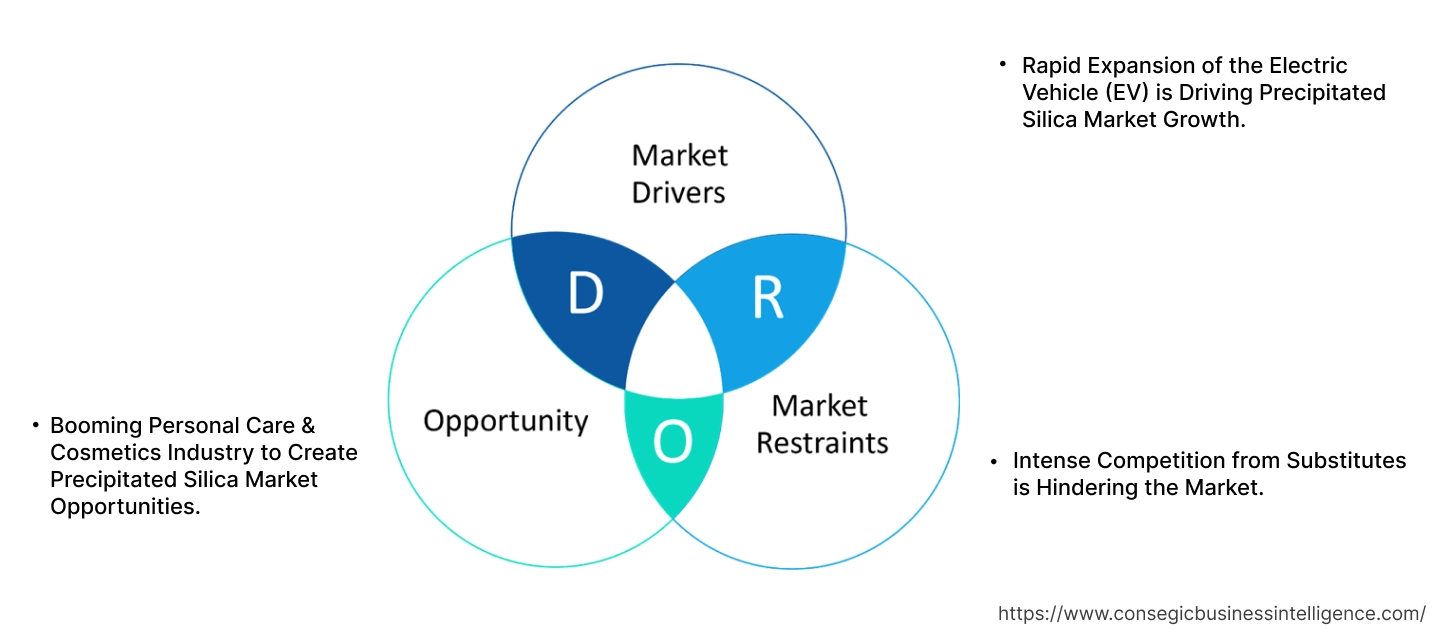Precipitated Silica Market Size:
The Precipitated Silica Market size is growing with a CAGR of 6.5% during the forecast period (2025-2032), and the market is projected to be valued at USD 5.18 Billion by 2032 from USD 3.34 Billion in 2024. Additionally, the market value for 2025 is attributed to USD 3.15 Billion.
Precipitated Silica Market Scope & Overview:
Precipitated silica is an amorphous form of synthetic silicon dioxide that is produced by chemically precipitating silicate salts with a mineral acid. It is considered safe and is highly valued for its high surface area, porous structure, purity, and ability to act as a reinforcing agent. Its properties are able to be precisely controlled during manufacturing, making it a suitable option across various industries. This includes the rubber sector, where it enhances tire performance. Additionally, in the food and feed sectors it is used as an anti-caking agent and in personal care products such as toothpaste. It also acts as a matting agent in paints and coatings and is increasingly vital in electronics for battery components, contributing to market growth.
How is AI impacting the Precipitated Silica Market?:
Generative AI is playing an increasingly important role in the precipitated silica market, impacting both material discovery and production efficiency. AI is accelerating the process of discovering new materials and predicting their properties. Also, AI-based simulations help optimize production processes, improving efficiency and sustainability in the manufacturing of precipitated silica. Moreover, AI is expected to further revolutionize the industry by enabling the development of high-performance silica for various applications, including tires and batteries.
Precipitated Silica Market Dynamics - (DRO) :
Key Drivers:
Rapid Expansion of the Electric Vehicle (EV) is Driving Precipitated Silica Market Growth
The growing electric vehicle market is driving high needs due to precipitated silica's utilization in EV tires and battery separators. In tires, it's essential for green tire technology, significantly lowering rolling resistance to extend EV range. For batteries, precipitated silica improves the thermal stability and safety of lithium-ion battery separators, while also improving ion conductivity for more efficient charging and a longer battery lifespan.
- For instance, according to IEA, in 2024, the global electric car fleet had reached more than 55 million vehicles. This figure represents roughly 4% of the entire passenger car fleet worldwide, and an increase in 3x compared to the total electric car fleet size recorded in 2021.
Hence, due to the aforementioned factors, the rapid adoption of the electric vehicle is driving precipitating silica market growth.
Key Restraints:
Intense Competition from Substitutes is Hindering the Market
Intense competition from substitute materials is creating pressure, particularly in the rubber industry, where carbon black remains a strong, and more cost-effective, alternative for tire manufacturing despite silica's advantages in promoting fuel efficiency and wet grip. Beyond rubber, waxes and other functional fillers offer competitive performance in paints and coatings as matting agents and rheology modifiers. Similarly, in the food and pharmaceutical sectors, calcium carbonate, magnesium stearate, and various starches act as viable anti-caking or flow agents. This landscape of diverse, and cheaper alternatives makes precipitated silica manufacturers emphasize the unique performance benefits of their product to maintain and expand market share. These aforementioned factors are contributing to hindrances in the precipitated silica market expansion.
Future Opportunities :
Booming Personal Care & Cosmetics Industry to Create Precipitated Silica Market Opportunities.
The rising personal care and cosmetics sector is expected to drive the demand for precipitated silica due to the changing consumer preferences for sophisticated, multi-functional products and an increased focus on personal grooming. Precipitated silica is a highly valued ingredient in this sector due to its versatile properties such as it functions as an effective abrasive and polishing agent in toothpastes, an oil-absorbing and mattifying agent in skincare and makeup, and a valuable thickening and rheology control agent in various cosmetic formulations.
- For instance, according to IBEF, the beauty and personal care market is expected to grow by more than 10% in India by 2028
Thus, as per analysis, the booming personal care & cosmetics sector is expected to create precipitated silica market opportunities.
Precipitated Silica Market Segmental Analysis :
By Application:
Based on Application, the market is categorized into reinforcing fillers, thickening agents, abrasives/polishing agents, adsorbents/carriers, and others.
Trends in Application:
- The escalating global demand for green tires is creating high need for reinforcing fillers.
- The demand for precipitated silica as an abrasive and polishing agent is particularly driven by toothpaste.
The reinforcing fillers segment accounted for the largest precipitated silica market share in 2024 and is expected to grow at the fastest CAGR over the forecast period.
- The reinforcing fillers segment showcased prominence due to its high utilization in the tire sector, especially the rising trend for green tires and electric vehicle tires.
- Precipitated silica is important for these advanced tires as it significantly boosts fuel efficiency by reducing rolling resistance, while simultaneously enhancing wet grip and overall durability, directly meeting stringent environmental regulations and consumer desires for high-performance, eco-friendly vehicles.
- For instance, according to Smithers, the green tires market is expected to experience a growth rate of more than 8% from 2022 to 2024 and is expected to be lucrative by 2027.
- Thus, as per the market analysis, the reinforcing fillers segment is dominating as well as expected to grow at the fastest CAGR in the precipitated silica market expansion.
By End Use:
Based on the End Use, the market is categorized into rubber, food & feed, paints & coatings, adhesives & sealants, personal care & cosmetics, and others.
Trends in the End Use
- The increasing requirement for green tires is contributing to the use of precipitated silica in the rubber sector.
The rubber segment accounted for the largest precipitated silica market share of 43.17% in 2024 and is expected to grow at the fastest CAGR over the forecast period.
- The rubber segment holds prominence due to the global trend for green tires and the rapid adoption of the electric vehicle sector. Precipitated silica is an important component in these advanced tires, significantly enhancing fuel efficiency by reducing rolling resistance and extending EV range, while simultaneously improving critical safety features like wet grip.
- Additionally, the features provided align with increasingly stringent environmental regulations worldwide and a strong consumer preference for sustainable and high-performance automotive solutions.
- For instance, according to the IEA, the sale of electric vehicle grow by more than 20% in 2024 compared to last year, reaching around 10 million units sold.
- Thus, based on the market analysis, the rubber segment dominates precipitated silica market demand.
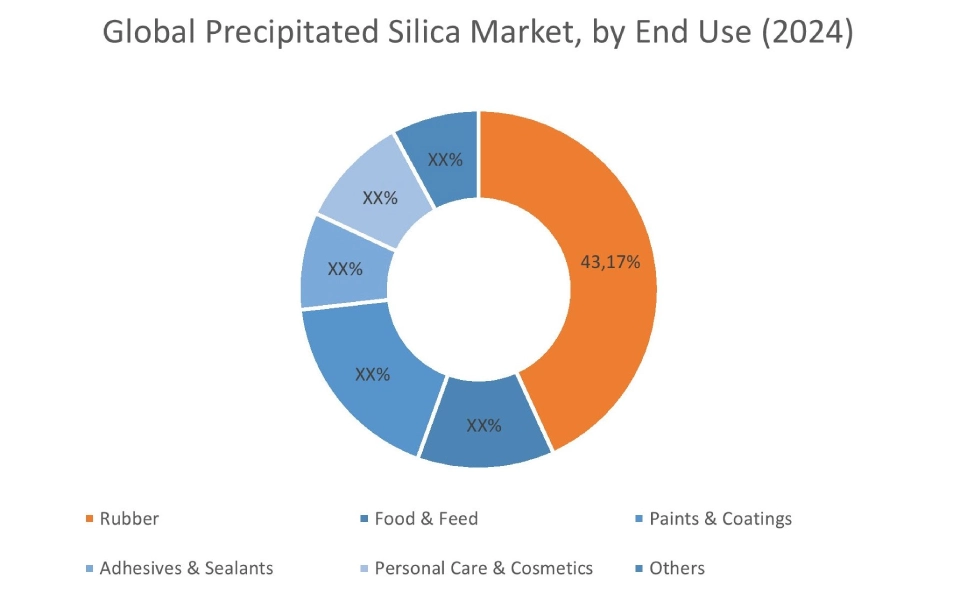
Regional Analysis:
The regional segment includes North America, Europe, Asia Pacific, the Middle East and Africa, and Latin America.
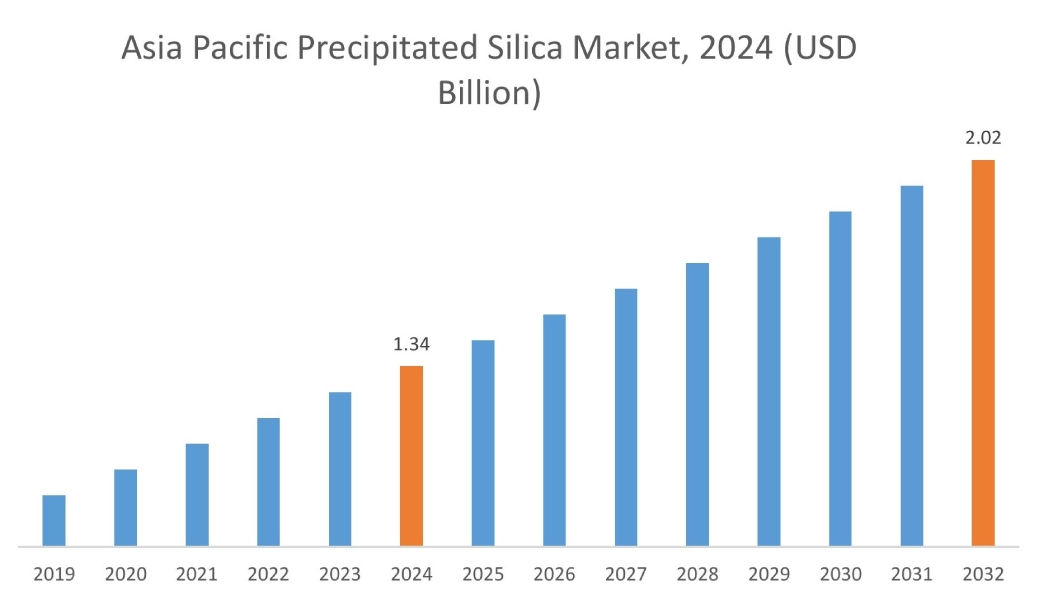
In 2024, Asia Pacific accounted for the highest market share at 42.51% and was valued at USD 1.34 Billion and is expected to reach USD 2.02 Billion in 2032. In Asia Pacific, China accounted for a market share of 39.78% during the base year of 2024. The Asia-Pacific region's is a global leader in automotive manufacturing and EV adoption with countries such as China, India, Japan, and South Korea at the forefront, contributing to the high requirement of precipitated silica for manufacturing of tires for these electric vehicles. These tires critically rely on precipitated silica to reduce rolling resistance for extending EV battery range and boosting energy efficiency.
- For instance, according to Chosun, the electric vehicles sales in first quarter of experienced a growth rate of more than 45% in 2023 in South Korea, prior to the first quarter in the previous year
Therefore, as per the Precipitated silica market analysis, the above-mentioned factors are contributing to the region’s dominance in the market trend.
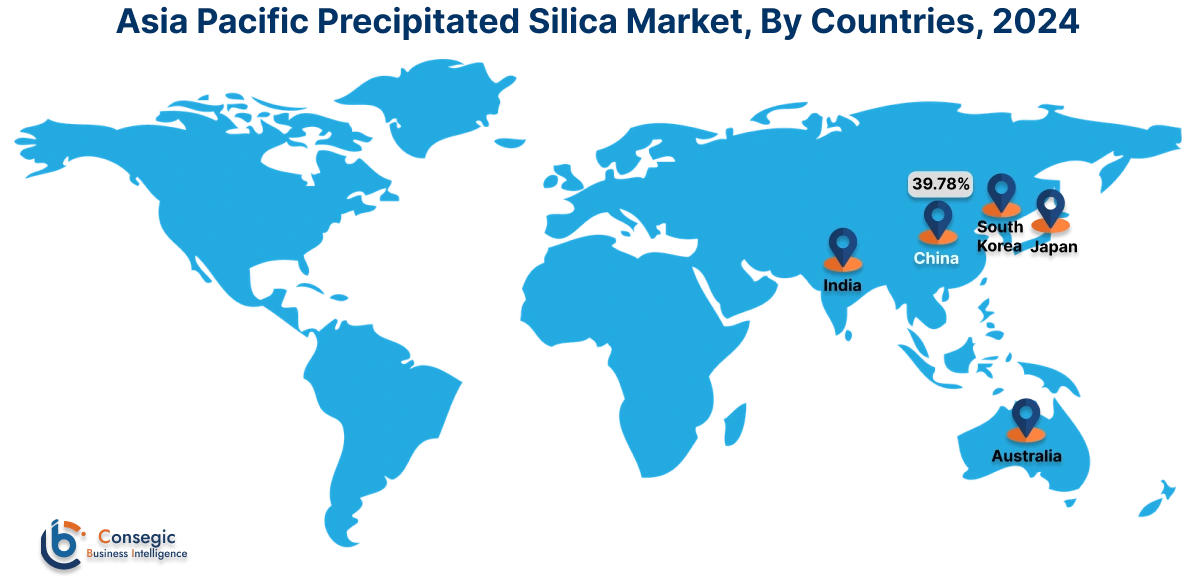
In Europe, the precipitated silica industry is experiencing the fastest growth with a CAGR of 8.6% over the forecast period. Europe's strong beauty sector drives the demand for this versatile ingredient. Precipitated silica is highly valued in oral care for its controlled abrasive and polishing properties in toothpaste. In skincare and makeup, it acts as an excellent oil-absorbing and mattifying agent, crucial for controlling shine and enhancing product finish. It also serves as a thickening and rheology control agent, improving product stability and texture. This trend is further increased due to the European consumer preferences for natural, organic, and performance-driven formulations, as well as a strong focus on sustainability and transparency. Thus, these aforementioned factors are influencing the Precipitated silica market demand in this region.
The increase in consumption of processed and packaged foods in North America is driving the region's precipitated silica market. This is attributed due to the consumers demand for convenience and extended product shelf life in increasingly busy lifestyles, relies on this compound as a crucial anti-caking agent. It prevents powdered and granulated ingredients in items like instant mixes, spices, and protein powders from clumping, thus maintaining product quality, ensuring ease of use, and supporting efficient supply chains. Thus, as per the Precipitated silica market analysis, these factors are contributing to the Precipitated silica market growth in this region.
The strong growth in construction and infrastructure development across the Middle East and Africa requires precipitated silica. The market in this region is driven by rapid urbanization, and substantial government and private investments, particularly in the GCC with megaprojects such as NEOM, where high requirement for advanced construction materials is rising. Furthermore, a growing focus on sustainable and high-performance building materials along with efforts to address infrastructure gaps across Africa, creates a high need for this compound in paints, coatings, adhesives, and sealants, contributing to Precipitated silica market trends for the region.
The rise in food and pharmaceutical applications is one of the key factors contributing to the need for precipitated silica in Latin America. In the food sector, the requirement for convenience is boosting consumption of processed and packaged foods. This compound is an important component due to its usage as an anti-caking and free-flow agent, ensuring product quality and shelf life in items ranging from instant mixes to spices, and supporting the growing e-commerce grocery market. Thus, as per the market analysis, these aforementioned factors are contributing to the precipitated silica market trends in the region.
Top Key Players and Market Share Insights:
The Global Precipitated Silica Market is highly competitive with major players providing products to the national and international markets. Key players are adopting several strategies in research and development (R&D) and product innovation to hold a strong position in the global Precipitated Silica market. Key players in the Precipitated Silica industry include
- Anten Chemical Co. Ltd. (China)
- Evonik Industries (Germany)
- MLA Group (India)
- Tosoh Silica Corporation (Japan)
- Madhu Silica Pvt. Ltd (India)
- PPG Industries Incorporated (U.S.)
- Huber Engineered Materials (U.S.)
- IQE Group (UK)
- Solvay SA (Belgium)
- PQ Corporation (U.S.)
Precipitated Silica Market Report Insights :
| Report Attributes | Report Details |
| Study Timeline | 2019-2032 |
| Market Size in 2032 | USD 5.18 Billion |
| CAGR (2025-2032) | 6.5% |
| By Application |
|
| By End Use |
|
| By Region |
|
| Key Players |
|
| North America | U.S. Canada Mexico |
| Europe | U.K. Germany France Spain Italy Russia Benelux Rest of Europe |
| APAC | China South Korea Japan India Australia ASEAN Rest of Asia-Pacific |
| Middle East and Africa | GCC Turkey South Africa Rest of MEA |
| LATAM | Brazil Argentina Chile Rest of LATAM |
| Report Coverage |
|
Key Questions Answered in the Report
How big is the Precipitated Silica market? +
In 2024, the Precipitated Silica market is USD 3.15 Billion.
Which is the fastest-growing region in the Precipitated Silica market? +
Europe is the fastest-growing region in the Precipitated Silica market.
What specific segmentation details are covered in the Precipitated Silica market? +
By Application and End Use segmentation details are covered in the Precipitated Silica market.
Who are the major players in the Precipitated Silica market? +
Anten Chemical Co. Ltd. (China), Evonik Industries (Germany), PPG Industries Incorporated (U.S.), Huber Engineered Materials (U.S.), IQE Group (UK) are some of the major players in the market.
